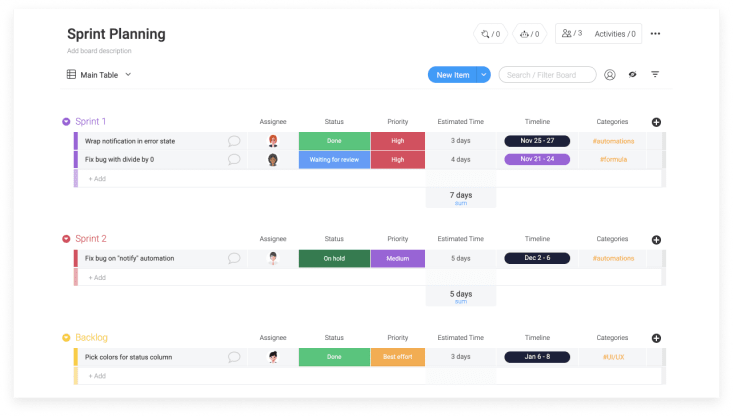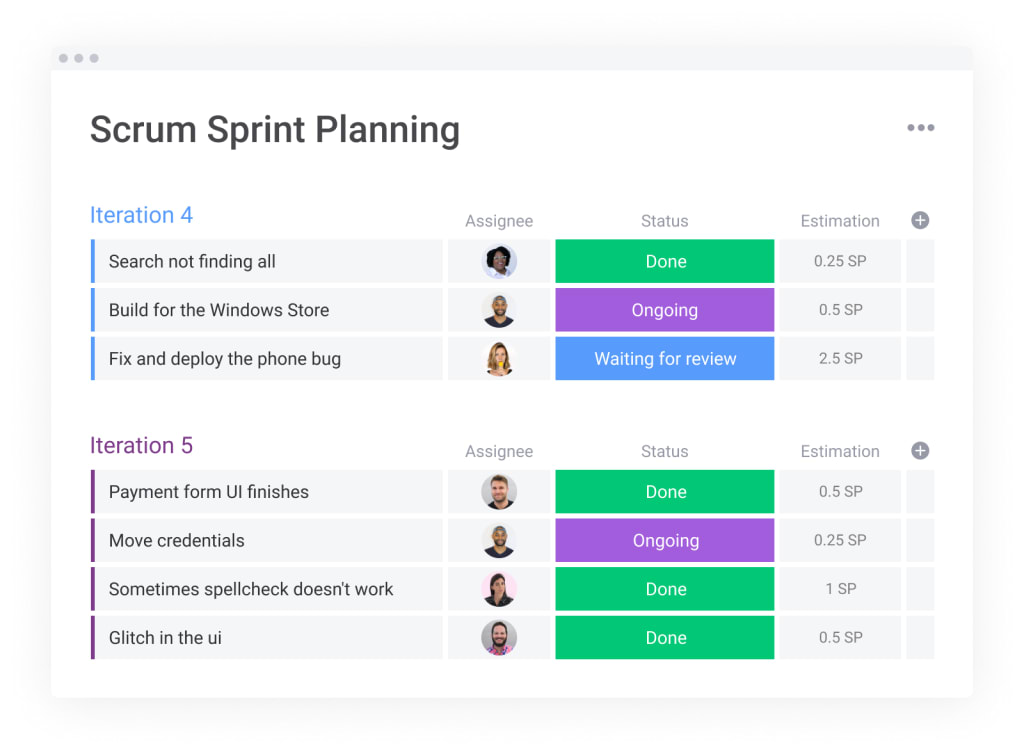TL;DR
For many development teams, the key to shipping better products faster lies in the Scrum framework. But more specifically, it’s about building an effective Scrum team. A Scrum team is a small, dedicated group that develops, delivers, and sustains complex products through iterative cycles, unlocking higher efficiency, better communication, and greater stakeholder satisfaction.
While the Scrum guide is easy to learn, mastering its application is the real challenge. It requires the right structure, mindset, and tools to truly succeed. This guide breaks down everything you need to know, from core roles and responsibilities to overcoming common hurdles.
Let’s dive in.
A Scrum team is a small, cross-functional group, typically 3-9 members, that includes a Product Owner, a Scrum Master, and Developers. This team works in iterative cycles called sprints to deliver value incrementally. Success hinges on clear accountabilities, effective collaboration during key events like the Daily Scrum and Sprint Retrospective, and overcoming common challenges like scope creep with a flexible platform that provides full visibility.
What is a Scrum team?
A Scrum team is the fundamental unit of Scrum. It’s a cohesive group of professionals focused on delivering a valuable, usable product increment every sprint. As a project management framework, Scrum relies on this teamwork to carry out projects in iterations, with each cycle building upon the last.
Many people place Scrum under the umbrella of agile project management, which prioritizes adaptability and speed. While widely used by software development teams, Scrum principles can be scaled for any kind of complex work. The optimal team size is small enough to remain nimble yet large enough to complete significant work within a sprint-typically between three and nine members (not including the Product Owner or Scrum Master).
Try monday devThe 3 Scrum team accountabilities (roles)
Within a Scrum team, there are three specific sets of accountabilities. While the team is cross-functional and collaborative, these distinct roles ensure that all aspects of the work are managed effectively, from strategic vision to daily execution.
The Product Owner
The Product Owner is accountable for maximizing the value of the product resulting from the work of the Scrum team. They are the voice of the customer and other stakeholders, responsible for managing the Product Backlog. This is the single source of work undertaken by the team.
- Setting priorities: They define the project vision and provide direction on what each sprint will cover.
- Managing the Product Backlog: This involves creating, prioritizing, and clearly communicating backlog items. The product backlog is a dynamic list of everything that needs to be done.
- Ensuring value delivery: They communicate the needs of users and stakeholders to the team to ensure every increment delivers the right value.
The Scrum Master
The Scrum Master is accountable for establishing Scrum as defined in the Scrum Guide. They do this by helping everyone understand Scrum theory and practice, both within the Scrum team and the organization. They are a true leader who serves the team and the wider organization.
At monday.com, we empower our teams to be self-managed. By encouraging each team member to take full accountability for their tasks, give updates on their progress, proactively solve problems, and collaborate efficiently, we’ve been able to boost team success. A platform like monday dev helps facilitate this by making processes transparent and removing blockers, which are key responsibilities of a Scrum Master.
The Developers
The Developers are the people in the Scrum team that are committed to creating any aspect of a usable increment each sprint. While the name comes from software development, in other contexts, the “developers” can be designers, writers, data analysts, or anyone executing the work.
- Executing the work: They carry out the tasks defined in the Sprint Backlog to move the project toward completion.
- Ensuring quality: They instill quality by adhering to a Definition of Done.
- Adapting daily: They are transparent about progress and challenges during the Daily Scrum meeting to ensure the team can adapt its plan toward the Sprint Goal.
Scrum team roles at a glance
Role Primary Focus Key Responsibilities Product Owner Value Manages and prioritizes the Product Backlog, represents stakeholders, defines acceptance criteria. Scrum Master Process Facilitates Scrum events, removes impediments, coaches the team in Scrum practices. Developers Delivery Creates the product increment, ensures quality, adapts the plan during the sprint.
How a Scrum team works: key events and artifacts
A Scrum team operates in a cycle of events, using key pieces of information called artifacts to make work visible and transparent. The core of this cycle is the sprint, a fixed-length event of one month or less where ideas are turned into value.

Key Events (The Scrum Meetings)
- The Sprint: The container for all other events. Each sprint is a short project to accomplish something significant.
- Sprint Planning: The team collaborates to plan the work to be performed in the sprint. This is where they create the Sprint Backlog.
- Daily Scrum: A 15-minute daily meeting for the Developers to inspect progress toward the Sprint Goal and adapt the Sprint Backlog as necessary.
- Sprint Review: Held at the end of the sprint to inspect the increment and adapt the Product Backlog if needed. It’s a working session, not a status report.
- Sprint Retrospective: An opportunity for the Scrum team to inspect itself and create a plan for improvements to be enacted during the next sprint.
Key Artifacts
- Product Backlog: The emergent, ordered list of what is needed to improve the product. It’s the single source of work for the Scrum team.
- Sprint Backlog: A plan by and for the Developers. It’s composed of the Sprint Goal (why), the set of Product Backlog items selected for the sprint (what), plus an actionable plan for delivering the increment (how).
- Increment: The sum of all Product Backlog items completed during a sprint and the value of the increments of all previous sprints. To be considered part of an increment, it must be usable and meet the team’s Definition of Done.
Common Scrum team challenges (and how to solve them)
Even with a perfect structure, Scrum teams face hurdles. Recognizing them is the first step to building a resilient, high-performing team.
- Scope creep: Uncontrolled changes or continuous growth in a project’s scope. Solution: The Product Owner must be disciplined in managing the Product Backlog. Using a platform like monday dev provides clear visibility into the sprint’s scope, making it easier to see the impact of new requests and protect the team from distractions.
- Poor communication: Silos between developers, the Product Owner, and stakeholders can lead to misunderstandings and rework. Solution: Centralize all communication and project artifacts in one place. monday dev connects engineering to the entire business ecosystem, ensuring everyone is aligned on goals and progress.
- Inaccurate estimation: Teams often struggle to estimate work, leading to missed deadlines. Solution: Use historical data to improve future forecasts. monday dev’s dashboards can track sprint velocity and performance over time, helping teams make more data-driven estimations.
See how monday dev provides real-time visibility to solve blockers and align teams.
How to empower your Scrum team with monday dev
Your ability to successfully adopt Scrum depends heavily on the platform you use to manage work, monitor progress, and facilitate communication. While traditional project management software can be rigid, a flexible Work OS like monday.com is built to adapt to your team’s unique process.
monday dev is designed to give product and engineering teams the flexibility to run processes their way while providing the real-time visibility managers need. It helps you:
- Enable team ownership: Build custom workflows for Agile, Scrum, Kanban, or hybrid approaches. Empower your team to iterate faster with flexible sprint planning boards and retrospective tools.
- Bridge engineering and the business: Align execution with business goals by connecting product, marketing, and leadership in one shared space. Everyone can see progress on epics and sprints at the portfolio level.
- Gain visibility without micromanagement: Use real-time dashboards and workload views to track progress, identify bottlenecks, and make fast decisions without disrupting your team’s flow.

With monday dev, your Scrum team can seamlessly sail through sprints, stay organized, and remain accountable. By automating routine tasks and centralizing information, you free up your team to focus on what they do best: building great products.

FAQs
What is the ideal Scrum team size?
The Scrum Guide recommends a team size of 10 or fewer people. This typically includes one Product Owner, one Scrum Master, and about eight or fewer Developers. This size is small enough to remain nimble and large enough to complete significant work within a sprint.
Can the Product Owner and Scrum Master be the same person?
It is not recommended. The Product Owner is focused on maximizing product value (the 'what'), while the Scrum Master is focused on the process and team effectiveness (the 'how'). Combining these roles can create a conflict of interest and diminish the effectiveness of both.
Does a Scrum Team have a team lead or manager?
A Scrum team is self-managing, meaning it doesn't have a traditional team lead or manager who assigns tasks. The team collectively decides how to accomplish its work. However, a development manager plays a crucial role in empowering the team, removing organizational impediments, and fostering professional growth.
What's the difference between a Scrum Team and an Agile Team?
Agile is a broad mindset and set of principles for iterative development. A Scrum team is a specific implementation of Agile. In other words, Scrum is one of several frameworks (like Kanban or XP) that a team can use to practice Agile. All Scrum teams are Agile, but not all Agile teams use Scrum.
How does monday.com help Scrum teams overcome the rigidity of other tools?
monday dev is built on a flexible Work OS, allowing teams to design their own workflows without being locked into a rigid structure. Unlike traditional tools, you can customize everything from sprint boards and bug tracking to cross-functional roadmaps, ensuring the platform adapts to your team's process, not the other way around.


